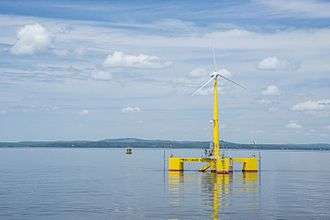VolturnUS (floating wind turbine)
The VolturnUS is a floating concrete structure that supports a wind turbine, designed by University of Maine Advanced Structures and Composites Center and deployed by DeepCwind Consortium in 2013. The VolturnUS can support wind turbines in water depths of 150 ft (46 m) or more. The DeepCwind Consortium and its partners deployed a 1/8th scale VolturnUS in 2013. Efforts are now underway by Maine Aqua Ventus 1, GP, LLC, to deploy to full-scale VolturnUS structures off the coast of Monhegan Island, Maine, in the UMaine Deepwater Offshore Wind Test Site. This demonstration project, known as New England Aqua Ventus I, is planned to deploy two 6 MW wind turbines by 2020.[2]

The University of Maine announced in September 2017 that its VolturnUS design became the first floating offshore wind turbine to meet American Bureau of Shipping requirements for floating offshore wind turbines, demonstrating feasibility of the VolturnUS concept.[3] The design review was conducted against the ABS Guide for Building and Classing Floating Offshore Wind Turbine Installations.[4]
History

North America’s first floating grid-connected wind turbine was lowered into the Penobscot River in Maine on 31 May 2013 by the University of Maine Advanced Structures and Composites Center and its partners.[5][6][7] The VolturnUS 1:8 was towed down the Penobscot River where it was deployed for 18 months in Castine, ME, along with a UMaine-developed floating LiDAR.[8]
The prototype employs a 20 kW Renewegy VP-20 wind turbine with a 9.6m rotor.[9] It is 65-foot-tall that is 1:8th the scale of a 6-megawatt (MW), 450-foot rotor diameter design.[10] VolturnUS 1:8 was the first grid-connected offshore wind turbine deployed in the Americas. The VolturnUS design utilizes a concrete semi-submersible floating hull and a composite materials tower[11][12] designed to reduce both capital and Operation & Maintenance costs, and to allow local manufacturing throughout the US and the World. The VolturnUS technology is the culmination of collaborative research and development conducted by the University of Maine-led DeepCwind Consortium.[13]
During its deployment, it experienced numerous storm events representative of design environmental conditions prescribed by the American Bureau of Shipping (ABS) Guide for Building and Classing Floating Offshore Wind Turbines, 2013.[14][15][16][17] It was taken out of the water in November 2014.[9]
VolturnUS floating concrete hull technology can support wind turbines in water depths of 45 meters or more, and has the potential to significantly reduce the cost of offshore wind. With 12 independent cost estimates from around the U.S. and the world, it has been found to significantly reduce costs compared to existing floating systems. The design has also received a complete third-party engineering review.[18]
Scaling up
In June 2016, the UMaine-led New England Aqua Ventus I project won top tier status from the US Department of Energy (DOE) Advanced Technology Demonstration Program for Offshore Wind. This means that the New England Aqua Ventus project is now automatically eligible for an additional $39.9 Million in construction funding from the DOE, as long as the project continues to meet its milestones. The developer asserts that the New England Aqua Ventus I project will likely become the first commercial scale floating wind project in the Americas.[18]
U.S. Senators Susan Collins and Angus King announced in June 2016 that Maine’s New England Aqua Ventus I floating offshore wind demonstration project was selected by the U.S. Department of Energy to participate in the Offshore Wind Advanced Technology Demonstration program.[19] The project is opposed by Senator Dow with Bill LR1613.[20]
New England Aqua Ventus I is one of two leading projects [21] that are each eligible for up to $39.9 million in additional funding over three years for the construction phase of the demonstration program.
In 2020, UMaine expects costs to be $74/MWh by 2027 and $57/MWh by 2032.[22]
See also
References
- Nation's first floating wind turbine launched, retrieved 2016-07-05
- "Floating Offshore Wind In Maine - Advanced Structures & Composites Center - University of Maine". Advanced Structures & Composites Center. Retrieved 2017-09-17.
- "UMaine's VolturnUS Passes ABS Review". Advanced Structures & Composites Center. 2017-09-14. Retrieved 2017-09-18.
- admin. "Rules & Guides". ww2.eagle.org. Retrieved 2017-09-18.
- Danko, Pete. "First US Floating Wind Turbine Launches In Maine". EarthTechling. Retrieved 2 December 2013.
- "Renewable energy: Wind power tests the waters". Nature News & Comment.
- "VolturnUS - Advanced Structures & Composites Center - University of Maine". Advanced Structures & Composites Center. Retrieved 2017-02-21.
- "UMaine's DeepCLiDAR Ready for the Market". Offshore Wind. 26 October 2016. Retrieved 27 February 2017.
- "DeepCwind Consortium - VolturnUS - Dyces Head Test Site". 4C Offshore. Retrieved 24 November 2016.
- "VolturnUS 1:8 windturbine launches in 2013". Retrieved 2016-07-05.
- proceedings.asmedigitalcollection.asme.org/proceeding.aspx?articleid=1911731
- onlinelibrary.wiley.com/doi/10.1002/we.1886/full
- "DeepCwind Consortium | Advanced Structures & Composites Center | University of Maine". composites.umaine.edu. Retrieved 2016-07-05.
- "VolturnUS 1:8". UMaine Advanced Structures and Composites Center. University of Maine. Retrieved 5 July 2016.
- ANTHONY MICHAEL VISELLI, PE. HABIB JOSEPH DAGHER, PH.D, PE. ANDREW JOSEPH GOUPEE, PH.D. VOLTURNUS 1:8 - DESIGN AND TESTING OF THE FIRST GRID-CONNECTED OFFSHORE WIND TURBINE IN THE U.S.A.
- "VolturnUS floating wind turbine celebrates one year of service". CompositesWorld. 2014. Retrieved 24 November 2016.
- http://www.pressherald.com/2016/07/10/umaine-offshore-wind-project-poised-to-take-off/
- "New England Aqua Ventus I Selected by the DOE for up to $39.9 Million in Additional Funding | Advanced Structures & Composites Center | University of Maine". composites.umaine.edu. Archived from the original on 2016-07-19. Retrieved 2016-07-05.
- "Maine Offshore Wind Project Moves to Top Tier of National Offshore Wind Demonstration Program". U.S. Senator Susan Collins. United States Senate. Retrieved 5 July 2016.
- "U.S Senator challenges floating demonstrator project". 4c Offshore. 10 February 2017. Retrieved 23 February 2017.
- "Offshore Wind Advanced Technology Demonstration Projects | Department of Energy". energy.gov. Retrieved 2017-02-21.
- Walter Musial, Philipp Beiter, and Jake Nunemaker (2020). "Cost of Floating Offshore Wind Energy Using New England Aqua Ventus Concrete Semisubmersible Technology" (PDF). National Renewable Energy Laboratory.CS1 maint: multiple names: authors list (link)
External links
- Aqua Ventus I, wind farm website
- Advance Structures and Composites Center - VoluturnUS